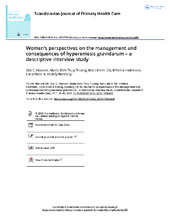| dc.contributor.author | Havnen, Gro Cecilie | en_US |
| dc.contributor.author | Truong, Maria Bich-Thuy | en_US |
| dc.contributor.author | Huynh Do, Mai-Linh | en_US |
| dc.contributor.author | Heitmann, Kristine | en_US |
| dc.contributor.author | Holst, Lone | en_US |
| dc.contributor.author | Nordeng, Hedvig Marie Egeland | en_US |
| dc.date.accessioned | 2019-08-23T11:48:48Z | |
| dc.date.available | 2019-08-23T11:48:48Z | |
| dc.date.issued | 2019 | |
| dc.Published | Havnen GC, Truong BT, Huynh Do M, Heitmann K, Holst L, Nordeng HME. Women's perspectives on the management and consequences of hyperemesis gravidarum - a descriptive interview study. Scandinavian Journal of Primary Health Care. 2019;37(1):30-40 | eng |
| dc.identifier.issn | 1502-7724 | |
| dc.identifier.issn | 0281-3432 | |
| dc.identifier.uri | https://hdl.handle.net/1956/20720 | |
| dc.description.abstract | Objective: Hyperemesis gravidarum (HG) affects 0.3–3% of pregnant women and is a leading cause of hospitalization in early pregnancy. The aim of the study was to investigate women’s treatment and management of HG, as well as the consequences of HG on women’s daily life. Design and setting: A cross-sectional study based on a structured telephone interview and an online questionnaire. Participants were recruited by social media and by the Norwegian patient’s organization for HG. Subjects: Norwegian women that experienced HG. Main outcome measure: Women’s perspectives on management and consequences of HG. Results: The study included 107 women. Maternal morbidity was profound; about 3/4 of participants were hospitalized due to HG, and the majority showed clinical signs of dehydration (79%), ketonuria (75%), and >5% weight loss (84%). Antiemetics were used by >90% and frequently prescribed “as needed”. Metoclopramide (71%) and meclozine (51%) were most commonly used. Participants described HG as having severe psychosocial consequences and profound impact on daily activities. Almost two out of five reported thoughts of elective abortion, and 8 women had at least one elective pregnancy termination due to HG. Overall, 20 women (19%) changed GPs due to dissatisfaction with HG management. Conclusion: Despite the high psychosocial burden and major impact on daily activities, many women with HG reported a lack of support from healthcare professionals and suboptimal management. Greater awareness and knowledge among healthcare professionals is needed to improve care for women with HG. | en_US |
| dc.language.iso | eng | eng |
| dc.publisher | Taylor & Francis | eng |
| dc.rights | Attribution CC BY | eng |
| dc.rights.uri | http://creativecommons.org/licenses/by/4.0 | eng |
| dc.subject | Hyperemesis gravidarum (HG) | eng |
| dc.subject | Nausea and vomiting in pregnancy (NVP) | eng |
| dc.subject | patient perspectives | eng |
| dc.subject | HG management | eng |
| dc.subject | Pregnancy | eng |
| dc.title | Women's perspectives on the management and consequences of hyperemesis gravidarum - a descriptive interview study | en_US |
| dc.type | Peer reviewed | |
| dc.type | Journal article | |
| dc.date.updated | 2019-05-16T07:16:39Z | |
| dc.description.version | publishedVersion | en_US |
| dc.rights.holder | Copyright 2019 The Author(s) | |
| dc.identifier.doi | https://doi.org/10.1080/02813432.2019.1569424 | |
| dc.identifier.cristin | 1697885 | |
| dc.source.journal | Scandinavian Journal of Primary Health Care | |

